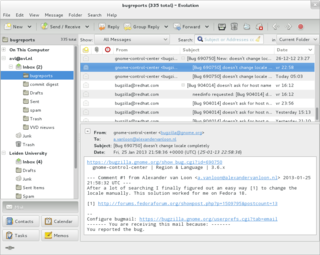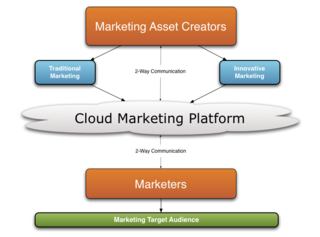
Email is a method of transmitting and receiving messages using electronic devices. It was conceived in the late–20th century as the digital version of, or counterpart to, mail. Email is a ubiquitous and very widely used communication medium; in current use, an email address is often treated as a basic and necessary part of many processes in business, commerce, government, education, entertainment, and other spheres of daily life in most countries.
Permission marketing is a type of advertising in which the people who are supposed to see the ads can choose whether or not to get them. This marketing type is becoming increasingly popular in digital marketing. Seth Godin first introduced the concept in his book “Permission Marketing: Turning Strangers Into Friends, And Friends Into Customers.”
In marketing and sales, marketing collateral is a collection of media used to support the sales of a product or service. Historically, the term "collateral" specifically referred to brochures or sell sheets developed as sales support tools. These sales aids are intended to make the sales effort easier and more effective.
When a message is replied to in e-mail, Internet forums, or Usenet, the original can often be included, or "quoted", in a variety of different posting styles.

Direct marketing is a form of communicating an offer, where organizations communicate directly to a pre-selected customer and supply a method for a direct response. Among practitioners, it is also known as direct response marketing. In contrast to direct marketing, advertising is more of a mass-message nature.
Marketing communications refers to the use of different marketing channels and tools in combination. Marketing communication channels focus on how businesses communicate a message to their desired market, or the market in general. It is also in charge of the internal communications of the organization. Marketing communication tools include advertising, personal selling, direct marketing, sponsorship, communication, public relations, social media, customer journey and promotion.
Email marketing is the act of sending a commercial message, typically to a group of people, using email. In its broadest sense, every email sent to a potential or current customer could be considered email marketing. It involves using email to send advertisements, request business, or solicit sales or donations. The term usually refers to sending email messages with the purpose of enhancing a merchant's relationship with current or previous customers, encouraging customer loyalty and repeat business, acquiring new customers or convincing current customers to purchase something immediately, and sharing third-party ads.
Cost per action (CPA), also sometimes misconstrued in marketing environments as cost per acquisition, is an online advertising measurement and pricing model referring to a specified action, for example, a sale, click, or form submit.

An advertising campaign or marketing campaign is a series of advertisement messages that share a single idea and theme which make up an integrated marketing communication (IMC). An IMC is a platform in which a group of people can group their ideas, beliefs, and concepts into one large media base. Advertising campaigns utilize diverse media channels over a particular time frame and target identified audiences.
In online marketing, a landing page, sometimes known as a "lead capture page", "single property page", "static page", "squeeze page" or a "destination page", is a single web page that appears in response to clicking on a search engine optimized search result, marketing promotion, marketing email or an online advertisement. The landing page will usually display directed sales copy that is a logical extension of the advertisement, search result or link. Landing pages are used for lead generation. The actions that a visitor takes on a landing page are what determine an advertiser's conversion rate. A landing page may be part of a microsite or a single page within an organization's main web site.
Mobile marketing is a multi-channel online marketing technique focused at reaching a specific audience on their smartphones, feature phones, tablets, or any other related devices through websites, e-mail, SMS and MMS, social media, or mobile applications. Mobile marketing can provide customers with time and location sensitive, personalized information that promotes goods, services, appointment reminders and ideas. In a more theoretical manner, academic Andreas Kaplan defines mobile marketing as "any marketing activity conducted through a ubiquitous network to which consumers are constantly connected using a personal mobile device".
A challenge–response system is a type of that automatically sends a reply with a challenge to the (alleged) sender of an incoming e-mail. It was originally designed in 1997 by Stan Weatherby, and was called Email Verification. In this reply, the purported sender is asked to perform some action to assure delivery of the original message, which would otherwise not be delivered. The action to perform typically takes relatively little effort to do once, but great effort to perform in large numbers. This effectively filters out spammers. Challenge–response systems only need to send challenges to unknown senders. Senders that have previously performed the challenging action, or who have previously been sent e-mail(s) to, would be automatically receive a challenge.
A squeeze page is a landing page created to solicit opt-in email addresses from prospective subscribers.
Lead management is a set of methodologies, systems, and practices designed to generate new potential business clientele, generally operated through a variety of marketing campaigns or programs. Lead management facilitates a business's connection between its outgoing consumer advertising and the responses to that advertising. These processes are designed for business-to-business and direct-to-consumer strategies. Lead management is in many cases a precursor to sales management, customer relationship management and customer experience management. This critical connectivity facilitates business profitability through the acquisition of new customers, selling to existing customers, and creating a market brand. This process has also been referred to as customer acquisition management.
Backscatter is incorrectly automated bounce messages sent by mail servers, typically as a side effect of incoming spam.
Dialogue marketing emerged in the early 2000s as companies engaged willing consumers in an ongoing dialogue to create lasting relationships. For example, based on data, marketers invite groups of likely consumers to connect with the company. The engagement process provides value to both the consumer and the company. Marketers use these opportunities as data collection points. The companies use the data to further customize their marketing messages and personalize the experience for their consumers and market segments. In exchange for sharing opinions, buying patterns, etc., consumers receive perks such as discounts, tips, and free trials as well as appropriate messaging from the company.
Call to action (CTA) is a marketing term for any text designed to prompt an immediate response or encourage an immediate sale. A CTA most often refers to the use of words or phrases that can be incorporated into sales scripts, advertising messages, or web pages, which compel an audience to act in a specific way.
Marketing automation refers to software platforms and technologies designed for marketing departments and organizations automate repetitive tasks and consolidate multi-channel interactions, tracking and web analytics, lead scoring, campaign management and reporting into one system. It often integrates with customer relationship management (CRM) and customer data platform (CDP) software.

Cloud marketing is the process of an organization's efforts to market their goods and services online through integrated digital experiences, by which they are specialized for every end-user. It aims to use advertising methods to give tailor-made adverts to customers based on their browsing history or interests via online applications through social media websites such as Facebook, Twitter and various online portals. Cloud marketing platforms could be supported by third-party providers that maintain the platform.
Lead validation is the process by which sales leads generated by internet marketing campaigns are separated from other types of conversions. Lead validation is crucial for effective internet marketing management; without it, companies can neither accurately evaluate the results of, nor efficiently improve, their SEO, PPC, display advertising, email, content marketing and social media campaigns.



